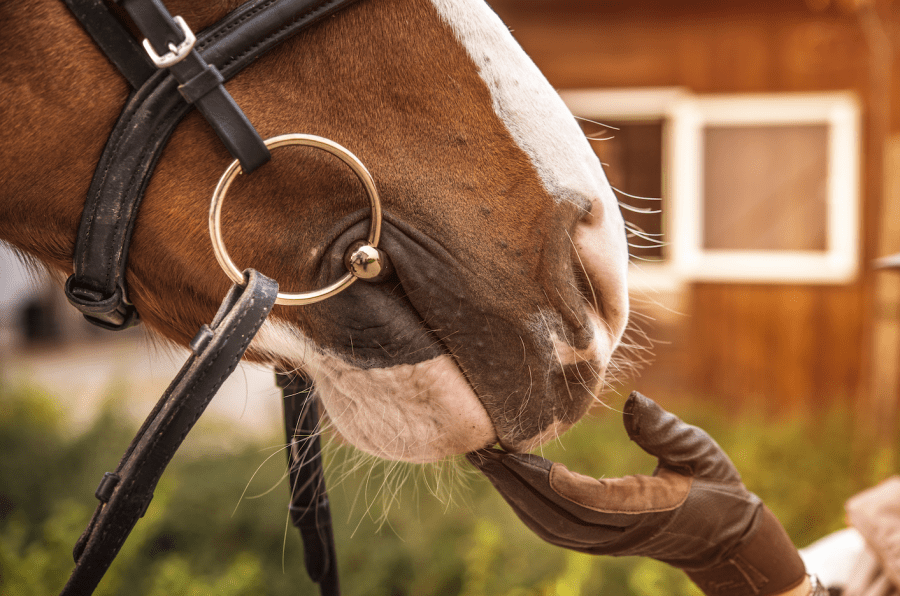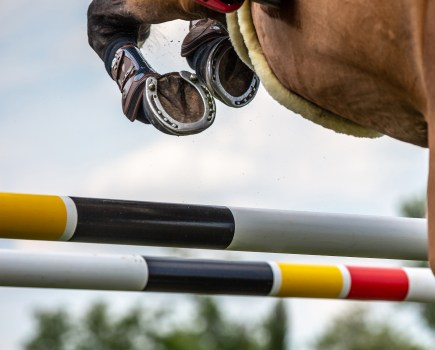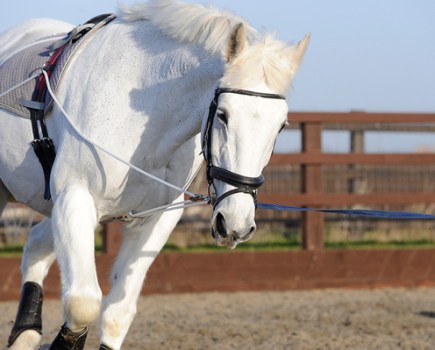Bits come in all sorts of shapes, sizes, styles and designs, and what suits one horse won’t work as well for another. With such a vast range to choose from, deciding which to use is a complex task. However, it is also a very important one, as a bit is a vital item of tack (unless you choose to ride bitless).
Before you put a bit in your horse’s mouth, you need to understand how it works. So we’ve put together this handy A-Z guide to bits to help you recognise all the different types and learn the action and affect they have on a horse’s mouth.
What is a bit?
A bit goes inside the horse’s mouth and sits in the space between their front and back teeth. They are usually made from types of metal such as stainless steel or copper, but they can also be made from synthetic materials such as rubber (more on this later).
The bit attaches to a bridle and the reins, and helps the rider control the horse’s speed and direction. Bits come in many styles and materials, which can make choosing the most suitable one for your individual horse confusing.
How to choose a bit
Sometimes bitting is trial and error. You might ride in one bit for a few days before trying another, and it could take several rounds of this to find the bit that your horse is happiest in.
Every horse’s mouth is different, so factoring their mouth conformation into your decision and choosing the best size for them is vital.
Important things to consider before choosing a bit include:
- Size and shape of your horse’s mouth
- How well-schooled your horse is
- The level of your riding and how experienced you are. Do you, for example, have an independent seat?
The aim is to select the mildest bit that still allows for clear communication with your horse.
Bear in mind that a rider with soft hands using a more severe bit will be a kinder experience for the horse than a rider with heavier hands using a soft bit.
It’s about getting the balance right for the two of you — and finding it could mean enlisting the help of a bitting consultant or an experienced trainer whose opinion and knowledge you trust.
Types of mouthpiece
The mouthpiece is the part of the bit that sits in the horse’s mouth, and it comes in a variety of different types. These can be:
Straight-bar mouthpieces

A straight-bar mouthpiece
As the name says, these are a solid bar of metal or other material such as rubber or plastic.
Straight and rigid Mullen Mouth bits exert steady and even pressure on the tongue and put less pressure on the tongue edges compared to jointed bits.
The stronger the rein the more pressure is directed onto the tongue and lower jaw bone.
Mullen Mouth bits
These horse bits can also be straight and flexible, or have a port. The latter has no joint but does have a slight curvature in the centre in order to accommodate the horse’s tongue, meaning no pressure is applied to it.
Single-jointed mouthpieces
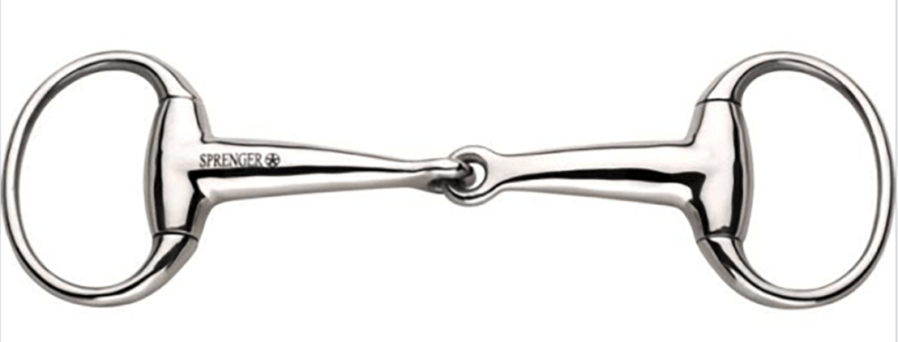
A single-jointed fixed snaffle
Single-jointed bits produce a ‘nutcracker’ pressure in the horse’s mouth.
Nutcracker action occurs when the reins are applied and the bit forms a V-shape in the mouth, applying pressure on to the edges of the tongue.
Double-jointed mouthpieces
Double-jointed bits have two pieces joined by a link, which distributes pressure from the rein aids over a wider surface area onto the horse’s tongue.
Styles of double-jointed bits include ported (with a raised portion in the centre), French link, Dr Bristol and ball double-jointed mouthpieces. Each operates differently, with double-jointed considered milder than single-jointed.
Bit texture
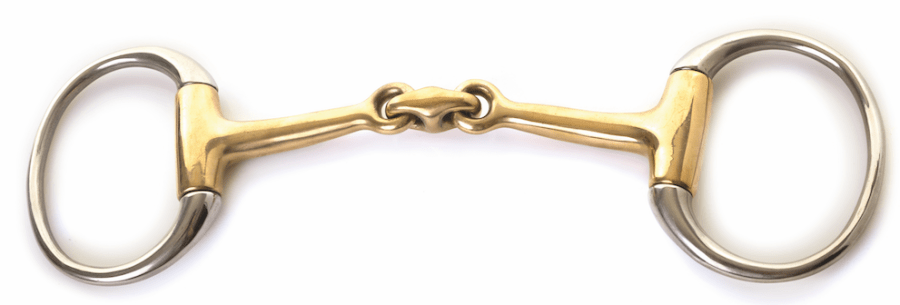
A double-jointed mouthpiece
Bits come with different textures of mouthpiece, such as twisted or textured mouthpieces.
Smooth mouthpieces are softer than textured or twisted ones.
The thickness of the mouthpiece in terms of the horse’s comfort depends largely on the size and shape of the individual horse’s mouth. Generally, thicker mouthpieces are believed to be kinder than thin bits.
Snaffle bits
Snaffle bits are one of the simplest bit designs, and consist of a mouthpiece and rings. The mouthpiece can be jointed, straight-bar or mullen mouth.
It’s often thought that snaffles are all mild bits, but this isn’t always true. While the pressure is more direct in the snaffle, as opposed to working with leverage, some mouthpiece designs accompanied by heavy hands on the reins will make it more severe.
There are several different types of snaffle bits:
D-ring snaffles
The rings on a D-ring snaffle are D-shaped rather than circular. The shape does not allow the bit to rotate, and also applies some lateral pressure on the horse’s mouth.
Eggbutt snaffles
Eggbutts are mild as they do not pinch the side of the mouth. The mouthpiece does not rotate, which can feel more comfortable to some horses.
Full cheek snaffles
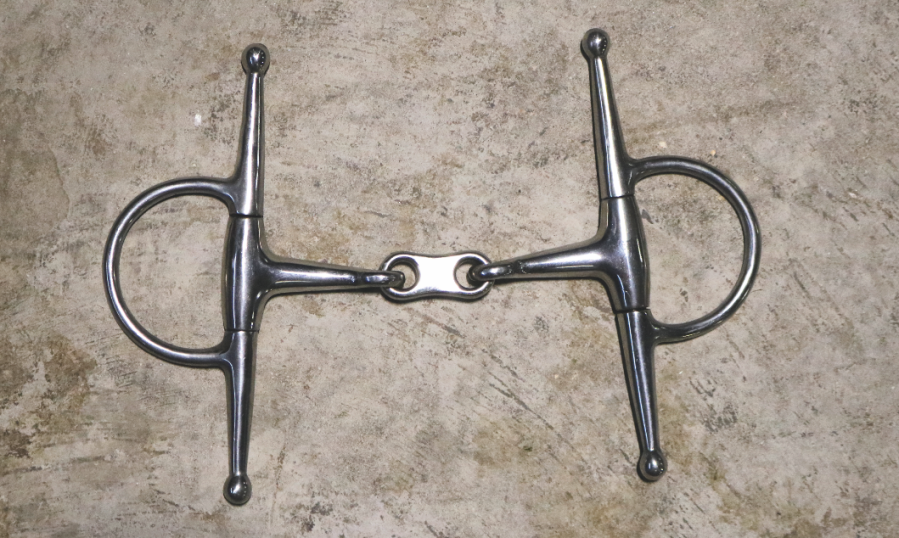
A full cheek
Full cheek horse bits have long arms on either side and the ring is attached to the arms. This helps with lateral guidance and keeps the bit’s position in the horse’s mouth consistent.
It is often used with young horses to help teach them steering without the bit being pulled through their mouth.
Loose-ring snaffles
The mouthpiece may slide on the full, loose ring, so that it rests in the most comfortable position for the horse, rather than being fixed in place, which can encourage the horse to relax its mouth and chew the bit.
Hanging cheek snaffles
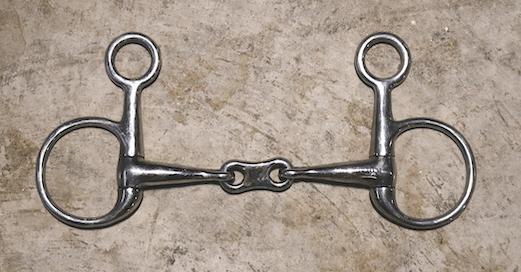
A hanging cheek
These have single round cheek rings to which the reins attach, while the bridle attaches to a piece about half an inch higher than the ring, giving the bit a very mild amount of leverage (poll pressure).
Loose-ring or fixed snaffle?
Choosing between these snaffle types will come down to what best suits you and your horse’s requirements.
Loose rings
Loose rings transmit the pressure of the reins directly onto the tongue and the lower jaw, without any leverage on the neck. The moveable rings may help to slightly compensate and balance unsteady/inexperienced rider hands too.
The horse may also be able to slightly lift the bit in their mouth by stretching the tongue and evading too strong a pressure from rein aids in the short term.
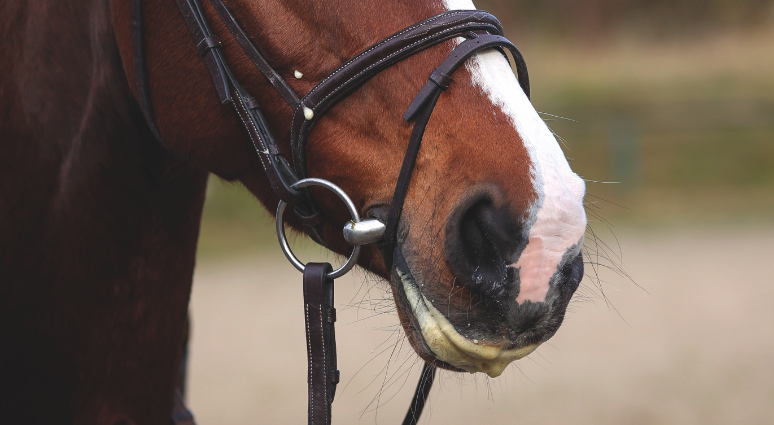
A loose ring snaffle
Loose rings are suitable for all horses doing all activities, starting from the early days of their ridden career and onwards.
Fixed rings
Fixed rings also transmit rein pressure directly on to the tongue and the lower jaw without leverage on the poll, but they do this in a more direct way.
Being fixed means these bits stay steady in the mouth, while smooth edges make it suitable for horses with sensitive mouth corners.
A fixed ring/cheekpiece is often recommended for a horse that likes to play with their bit, giving the rider an unsteady contact, or who fall out on a turn or when approaching a jump.
Horse bits: curbs
Curb bits work by applying indirect pressure on the horse’s mouth. This means you use less pressure on the reins to reach the same pressure on the bit that you would with a snaffle.
This makes it more severe depending on how much force is placed on the reins. The length of the shank also increases the severity, as longer shanks mean more pressure on the horse’s mouth.
Other than shank sizes, there are different shapes as well. The straighter the shank, the less warning the horse has before the pressure hits it.
Some are loose-jawed — that is, they let the mouthpiece rotate more — while others are not. Curb horse bits also come with a curb chain, which runs under the chin and applies pressure on the chin groove.
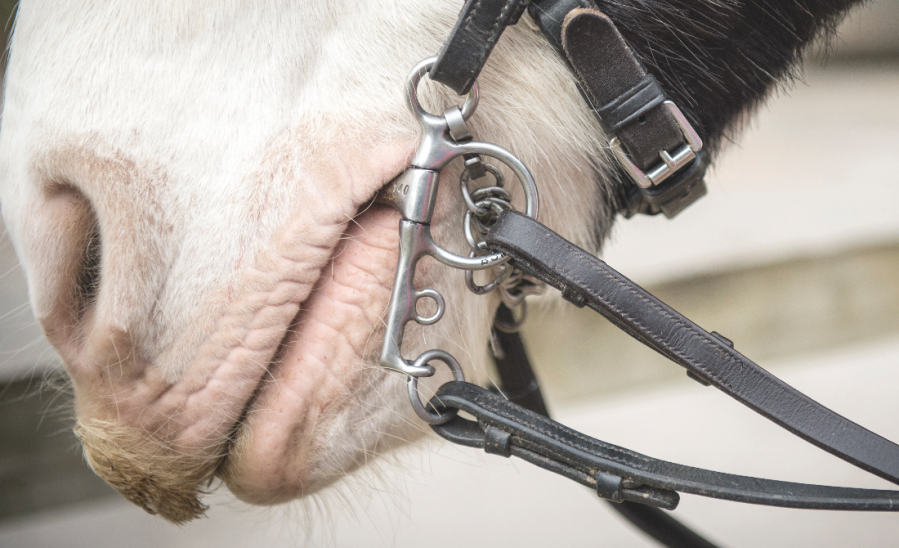
A Pelham with two reins
Types of curb bit include:
Weymouth curb
These are often part of a double bridle ensemble (more on this below) and usually have a solid mouthpiece, either straight or with a slight port. They are used alongside a snaffle.
Pelham
The Pelham is almost like a double bridle in that it allows for two sets of reins to be used at once, but it is only one mouthpiece. It’s often used to transition a horse to a double bridle.
Kimblewick
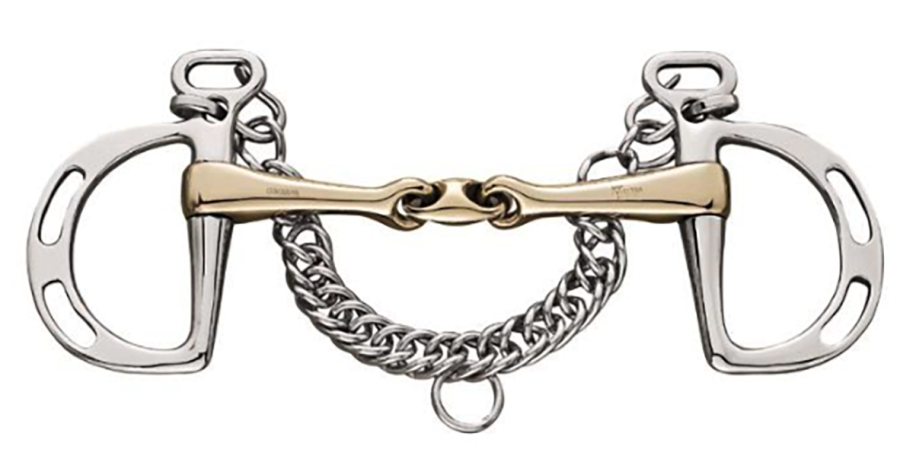
A Uxeter slotted kimblewick
These have a D-ring like the D-ring snaffle, as well as a curb strap or chain. The further the rein slides down the ring, the more poll pressure is applied.
A Uxeter slotted kimblewick has slots in the D-ring offering different holes to place the reins through. The higher the rein is applied, the less severe the leverage.
Three pressure points of a curb
Horse bits with a curb act on three different parts of the horse’s head:
- Over the tongue into the bars
- By lever action of the lower cheeks on the poll
- Through the curb chain on the chin groove.
Working in this way enables the rider to give clearer instructions and to have more control over strong and powerful horses.
However, a correct basic education and level of training (both horse and rider) is necessary when using these bits. A hand that is too strong, for example, will be particularly unkind if applied to a bit with such leverage on the poll and lower jaw.
A curb chain guard is recommended, too, in order to protect the sensitive chin area which is only covered by a thin layer of skin.
Horse bits: gags
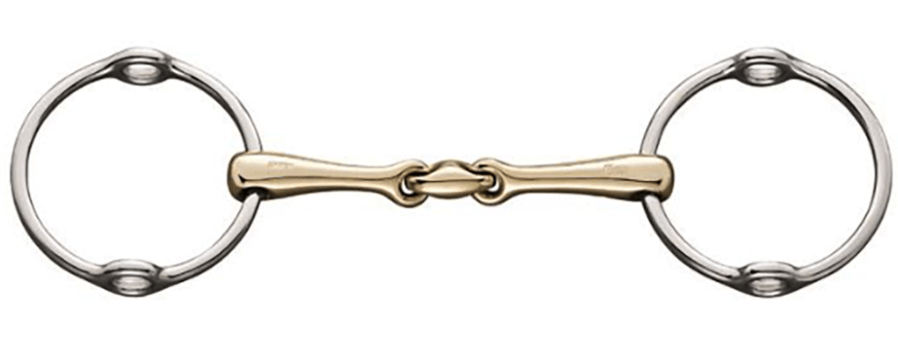
A Cheltenham gag
Gags work like snaffle bits but offer some leverage. They apply some pressure on the horse’s poll, depending on where the reins are attached.
Different types of gags are:
Cheltenham gag
A Cheltenham gag consists of a mouthpiece with two rings at either end, as in a snaffle, but each ring has two holes — one at the top and one at the bottom — through which the gag cheekpieces run in order to connect it to the bridle and reins.
Dutch gag
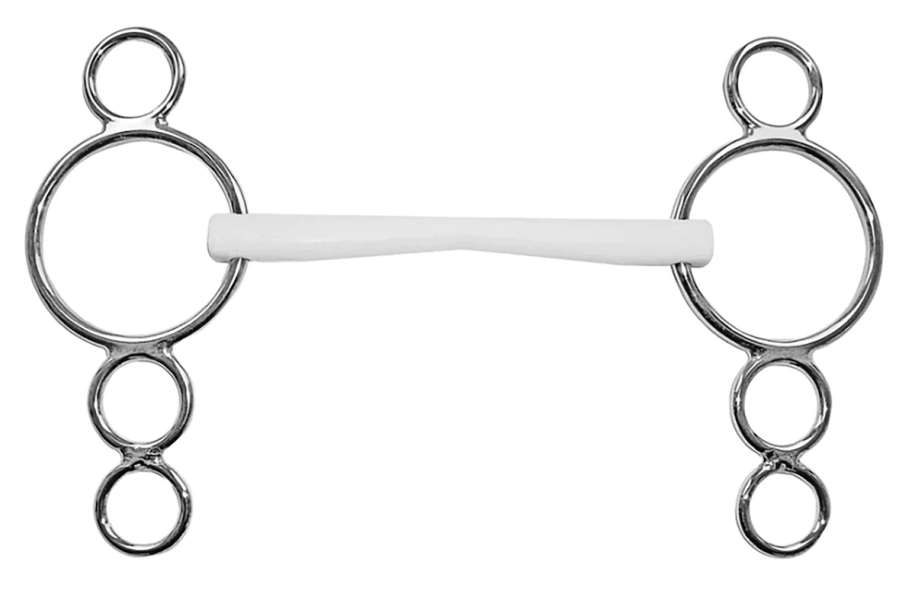
A Dutch gag with three rings
A Dutch gag (or three rings) bit consists of three or four rings.
- The ‘big’ ring is attached to the mouthpiece, with one smaller ring on top to attach the bridle’s cheekpiece.
- There are then a further one or two small rings beneath the ‘big’ ring.
- The reins can attach to any of the rings (but not the very top one) according to how much poll pressure you require.
- The lower the ring, the more leverage you have over the poll.
How gags work
When applying the reins to a gag, pressure is distributed from the tongue on to the lower jaw and the poll. This enables a rider to have more control over strong horses that evade the bit by putting their heads up, as the horse normally reacts to the gag’s leverage by lowering the head in order to avoid the pressure.
This effect is even more significant in a three-ring gag, as the leverage effect is increased by the side part.
Optimum effect is achieved by using two sets of reins: the main rein stays on the largest ring, acting on the tongue and lower jaw, while the second rein is on a lower ring and can be used to apply poll pressure when required.
These are best suited to experienced riders with a sensitive hand.
Double bridles
Double bridles are made up of two bits: a snaffle in the form of a bradoon and a curb.
The double bridle has the effects of both snaffles and curbs on the horse, with pressure on the bars and mouth from the snaffle bit, and on the chin, poll, tongue, palate and bars from the curb.
In the higher levels of dressage, the idea is to ride on the bradoon most of the time, engaging the curb only to encourage collection, making it a useful tool for refining control. In the wrong hands, it can be severe and harmful.
If you haven’t seen it yet, we have more information about double bridles and how they work here.
Use with caution
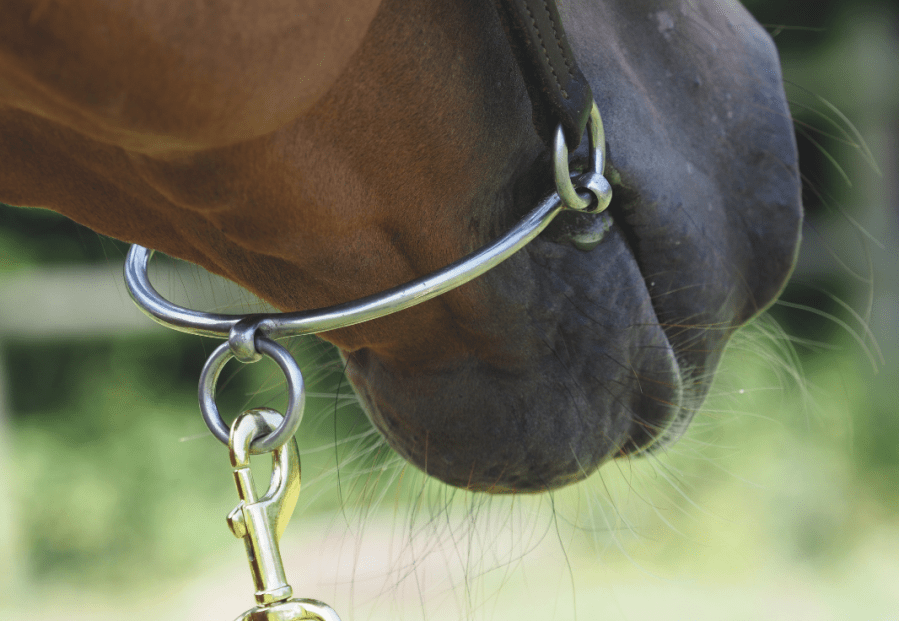
A Chifney bit is for leading horses only
Remember, it’s not always as simple as saying a bit is more severe than another. While this is the case in the literal sense, a ‘soft’ bit can be more severe and unkind to a horse when used by a rider with heavy hands, compared to a rider with kind hands using a ‘severe’ bit.
There are other types of horse bits not listed here, including more specialised ones or bits intended for behavioural correction or very sensitive mouths.
One such type is the Chifney bit, which is used to lead a horse from the ground, including horses that are prone to rearing, or those who need more control, such as stallions.
A Chifney bit should never be ridden in.
Regardless of their purpose, bits come into contact with a highly sensitive part of the horse’s body.
Even the gentlest bits can cause pain and discomfort when the person on the other end of the reins is using them heavy-handedly. This is the key message that every horse owner and rider should know and keep in mind when choosing which bit will best suit you and your horse.
Which horse bit is best for what?
Because bits work in different ways, you can help — or hinder — any issues you have by choosing a bit type accordingly.
Of course, you should rule out any discomfort being caused by another part of your tack or in the horse’s body before assuming the bit is the problem. Horse bits manufacturer Sprenger advises the following:
Horses with a sensitive mouth
A single-jointed bit means riders can give softer aids via the reins and are particularly suitable for horses that do not take the contact confidently.
Horses who occasionally pull
A double-jointed snaffle is ideal for horses that occasionally pull against the hand, but are too sensitive to be ridden in a stronger bit.
Horses who lean or evade the bit
A straight and rigid Mullen Mouth can be used for horses that dodge downwards and lean on the bit, or evade the rein and tend to get strong.
Horses who get strong
A straight and flexible Mullen Mouth can suit horses who become strong or unresponsive when working on the flat, or approaching a jump. These bits are usually accepted well by horses who dislike double-jointed bits.
Horses who have a big tongue
A Mullen Mouth with port allows more space for a fleshy tongue to sit underneath it. It can also correct issues such as horse’s putting their tongue out to the side of their mouth when worked, or getting the tongue over the bit. This bit type is also particularly suitable for horses who resist their rider’s hand.
How to fit a horse’s bit
Mouth conformation can have a direct effect on the bit’s action and how it fits in the horse’s mouth.
“Be mindful that the horse’s mouth hasn’t evolved to have room for the bit. There is no natural space between the tongue and roof of the mouth, so it is up to us to make sure the bit is as comfortable as it can be for the horse,” says Angela Rudrum from Equine Bitting Solutions.
“Some horses may have unusually large tongues, while others have small, thin lips. Some may have a narrow mouth and thin, delicate bars.
“A horse’s breed can sometimes determine their mouth conformation,” continues Angela. “Some breeds have typically thicker lips and tongues, such as the Irish Draught, which can leave little room for thicker bits, while some finer breeds like Thoroughbreds will have smaller tongues and less lip thickness and thinner bars.”
How to assess a horse’s mouth
1 Lip length and shape
“Look at the shape and length of the horse’s lips,” explains Angela. “Some have what is called a short smile; this is where the lips are short from the corner of the muzzle to the corner of the lip. A short smile can be challenging when you are adjusting the bit position in the mouth.
“Avoid raising the bit to an excessive height, as this can cause the horse’s lips to be uncomfortable and become too stretched, potentially causing them to split.”
2 Lip thickness
Have a feel of the horse’s lips from the outside.
“It’s easy to tell if a horse has fleshy lips as you can squeeze a handful and they can be quite prominent when looking at the horse’s head from the front,” says Angela.
“Thicker lips take up more room inside the mouth and so leave less room for thicker bits. When the bit is in position, thicker lips may appear to have more wrinkles than thinner lips.”
3 Inside the mouth
Do this when the horse is relaxed and not eating.
“From the side, gently separate the lips — top lip upwards and bottom lip downwards — so you can see the resting tongue, bars and tushes.
“Be careful not to pull the lips back towards the cheek teeth and to keep your fingers clear of these teeth,” advises Angela.
“Horses have incredibly powerful jaw strength, around 500psi, which can easily crush a finger if it’s mistaken for food.”
4 The tongue
Notice how the tongue sits in the mouth.
“A large, thick tongue may bulge out the sides and be the most prominent part of the mouth. It will appear thick and completely fill the mouth. A thinner bit would be beneficial for the horse so that it does not take up too much room and they can still easily swallow,” says Angela.
A thinner, narrow tongue sits neatly behind the incisors and doesn’t bulge beyond the bars. “Horses with a narrow upper and lower jaw can also have a narrow tongue, which means some bits with a wide lozenge or French link plate will be uncomfortable,” adds Angela.
5 Bars of the mouth
These are the spaces between the teeth and where the bit sits.
“The bars are the mouth are very sensitive as they are not covered with much cushioning and have only thin skin covering them,” explains Angela.
“Horses with large tongues and flesh lips will be able to support a bit, helping to keep it clear of the sensitive bars. However, horses with a thinner tongue and lips may show evasions to a bit that touches the bars. In this case, the horse may prefer a thicker bit to spread the pressure over a larger area.”
6 Roof of the mouth
The palate is a very important part of the horse’s mouth to consider when choosing a bit.
“Some horses have what’s called a low palate, which means the roof of the mouth sits fairly flat, without an arch. If the palate has a rounder, arched shape it can be called a high palate,” says Angela.
“The palate has visible ridges and it is soft and sensitive. If a bit affects the roof of the mouth, it can encourage the horse to open their mouth or raise their head.
“Some bits can cause injury to the roof of the mouth if they are too thick or make a ‘steeple’ shape when the rein aids are applied, especially if they horse has a low palate.”
Designers of horse bits
Sprenger horse bits
These bits are made from Aurigan, an alloy of copper, silicon, and zinc which has been developed specifically for using in horses’ mouths.
The manufacturers claim that using Aurigan helps your horse become more attentive and relaxed, improving the connection between horse and rider. The range was developed with horse mouth conformation in mind.
Research found the volume of the inside of the mouth was less than previously thought, leaving much less room for the bit. Sprenger used this information to develop their KK range of bits.
Informed Designs, by Hilary Vernon
This range of bits is made up of English bits designed and carefully constructed to complement the conformation of the horse’s mouth to improve comfort and communication.
Informed Designs is inspired by the theory that a comfortable horse will be a more relaxed horse and therefore a less resistant horse. The range includes snaffles, pelhams, doubles, daleheads, Liverpools and butterflies, with a variety of cheeks on these mouthpieces available.
Abbey England
These horse bits are made in the UK and there are more than 200 different bit patterns in stock. The range includes snaffles, gags, pelhams, double bridles, driving bits, and hackamores.
These horse bits are available in various materials including copper, stainless steel, sweet iron, rubber and vulcanite. They are made-to-measure bits which can easily be customised from existing parts for comfort and quality.
Nathe horse bits
These horse bits are made in Germany from a patented plastic material, and claim to offer a higher degree of comfort and control.
The secret of their effectiveness and flexibility is said to be a unique mouthpiece, protected by a worldwide patent.
Each bit has a stainless steel safety wire running through the mouthpiece for total security. They encourage salivation and are kind to the tongue, so are ideal for training young horses.
Neue Schule horse bits
Most Neue Schule bits are made from Salox. This range of dressage and competition bits are all designed with the shape of the horse’s mouth in mind.
The use of Tranz lozenge for comfort and communication gives even pressure over the tongue and away from the outer edges where the horse is more sensitive.
Myler horse bits
Designed by the Myler brothers, this range of horse bits claims to create a kinder, more of effective way of communication with your horse. The bits have a forward-curve shape to give the horse more tongue room to allow for swallowing. Myler bits have a no-pinch action and each side moves independently to make rider aids clearer.
Some of the horse bits in this range come with slots in the cheeks. The top slots work in a similar way to a full cheek bit with keepers holding the mouthpiece off the tongue and steady — until the rider uses the reins.
The bit returns to its original position once the rein aid is relaxed making the reward much clearer to your horse. Using the slots also gives some poll pressure, encouraging a horse to flex from the withers.
The range of Myler horse bits is split into three levels depending on your horse’s level of training. Level one is designed for young horses at the beginning of their training; level two is for horses with a basic training; level three is designed for more experienced horses.
All images: copyright Shutterstock, Sprenger, Your Horse Library/Kelsey Media/Mel Beale
Related content
- Bridles tried and tested for fit, performance and value for money
- Would your horse benefit from going bitless?
- Riding a strong horse? Why changing to a stronger bit might not be the solution
- Bridle fit and horse head anatomy: everything you need to know *VIDEO*
- How to keep horse teeth healthy and problem free

